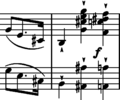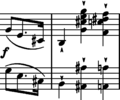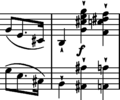



Issues : Centrally placed marks
|
b. 355
|
composition: Op. 11, Concerto in E minor, Mvt III
..
There are no doubts that category imprint: Differences between sources; Editorial revisions issues: GE revisions , Centrally placed marks |
||||||
|
b. 501
|
composition: Op. 11, Concerto in E minor, Mvt I
..
The fact of assigning category imprint: Interpretations within context; Differences between sources issues: GE revisions , Centrally placed marks |
||||||
|
b. 532
|
composition: Op. 11, Concerto in E minor, Mvt I
..
We preserve the original position of the staccato indication. It may mark a gradual change of articulation from legato to staccato during the chromatic sequence. category imprint: Source & stylistic information issues: Centrally placed marks |


 under 2nd triplet in
under 2nd triplet in 
 Major, Op. 10 No. 5. An appropriate shift was performed already in
Major, Op. 10 No. 5. An appropriate shift was performed already in 

 in
in 